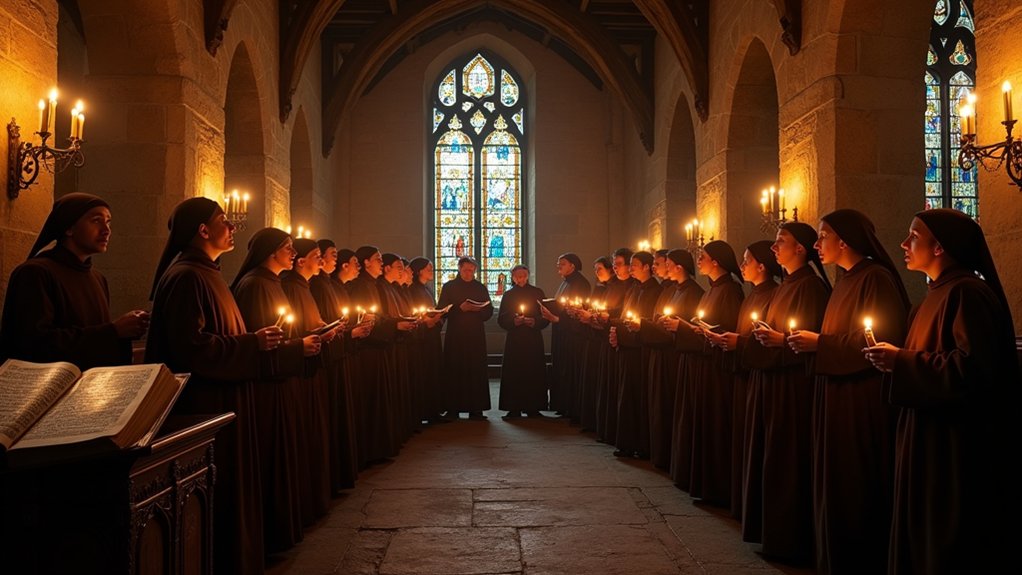
How did Byzantine culture and religion spread in Eastern Europe
Just how Byzantine culture and religion subtly transformed Eastern Europe reveals a fascinating blend of faith, politics, and innovation that shaped history.

Gregorian chant played a pivotal role in medieval worship, influencing many aspects of religious life and spiritual practice. As a unifying musical form, Gregorian chant established a consistent liturgical language that transcended regional differences, making worship feel connected across communities. Beyond sound, the chant shaped the spiritual environment and daily rhythms of monastic life, fostering meditation, prayer, and a sense of sacred time. It also laid the groundwork for future musical developments and helped preserve sacred texts through careful notation and tradition. Understanding these influences reveals how this ancient form of music became integral to medieval worship’s structure and experience—and why Gregorian chant continues to inspire spiritual seekers today.

Establishing a unified liturgical language played a key role in shaping medieval Christian worship. By adopting Latin as the primary liturgical language, the Church created consistency in prayer, ritual, and theology across regions. This shared liturgical language allowed believers from different cultures to participate in a common spiritual experience, strengthened ecclesial authority, and fostered cultural integration.
Gregorian chant played a key role in enhancing the spiritual atmosphere of worship in the medieval church. Through its gentle rhythm and sacred melodies, Gregorian chant created a peaceful setting that encouraged chant meditation and deep engagement with holy texts.
This meditative quality helped worshippers focus, nurtured devotion, and turned the worship space into a serene environment for spiritual reflection and communal reverence—showing how Gregorian chant united language, emotion, and the senses in meaningful worship.
Gregorian chant played a key role in influencing the development of polyphonic music, shaping how sacred music evolved in medieval worship.
Because Gregorian chant offered clear melodic lines and a stable spiritual framework, composers began layering voices, creating multiple simultaneous melodies that led to early polyphony.
Over time, the harmonic possibilities within Gregorian chant encouraged innovative techniques, allowing polyphonic music to grow into a richer, more expressive form that deepened the religious experience.
For anyone exploring the history of sacred sound, the spiritual roots of polyphonic music in Gregorian chant reveal how prayerful singing blossomed into intricate, interweaving vocal textures.
Gregorian chant was not only a form of worship; it was also vital for supporting the transmission of sacred texts. With the rise of chant notation, communities could accurately record and share prayers and scriptures, ensuring that sacred texts were preserved across generations.
This consistent method helped monks and clergy learn, teach, and repeat the liturgy faithfully, keeping sacred texts at the heart of medieval worship and safeguarding doctrinal integrity.
Gregorian chant and medieval worship spaces are deeply connected. In many churches, the flowing, unaccompanied melodies of Gregorian chant shaped how the building sounded and felt.
Architects designed stone walls, vaulted ceilings, and long naves to support vocal clarity, so the chant would carry evenly. Choirs were placed to maximize resonance, allowing the sound to travel without distortion.
This union of sound and structure helped worshippers enter a meditative state, experiencing the spiritual depth of Gregorian chant during services.
In medieval churches, architectural design enhanced the acoustics of Gregorian chant and made it easier for everyone to take part. This focus on fostering communal participation in services encouraged worshippers to join in simplified chanting, turning prayer into a shared spiritual practice.
Gregorian chant played a pivotal role in shaping medieval worship by unifying liturgical language and enriching the spiritual atmosphere. As a cornerstone of Christian spirituality, Gregorian chant fostered deep prayer, communal harmony, and reverence through clear, flowing melodies that supported monastic discipline and daily rituals. Over time, Gregorian chant influenced the development of polyphony, aided the accurate transmission of sacred texts, and even inspired the design and acoustics of worship spaces, reinforcing doctrinal integrity and shared participation across diverse cultures.

Just how Byzantine culture and religion subtly transformed Eastern Europe reveals a fascinating blend of faith, politics, and innovation that shaped history.

What mysteries did Olmec and Mayan religions unlock about life, power, and the cosmos? Their beliefs shaped civilizations in ways still felt today.

Bridging the seen and unseen, African art reveals deeper spiritual meanings—discover how creativity becomes a sacred dialogue in these cultures.

Linking sacred numbers to celestial events, the Maya intertwined math and religion in ways that still mystify scholars today. Discover their profound connection.

Only by examining religion can we grasp the deep values shaping cultures—discover how belief systems influence identity and social cohesion.

The transformative impact of culture on Buddhist practices reveals unexpected variations that challenge traditional interpretations and invite deeper exploration.